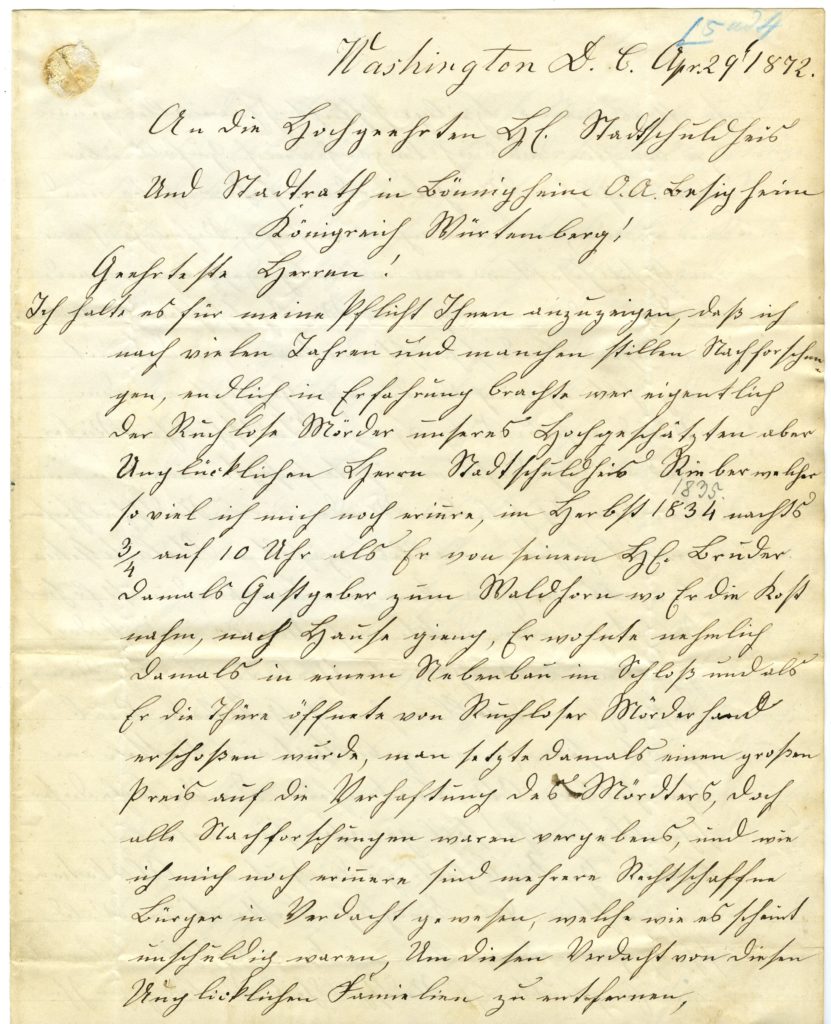
What have been the coldest cases ever solved?
A craveonline article by K. Thor Jensen, “The Longest Cold Cases in History that were Eventually Solved” lists several. At the top of the list stands the 1957 murder of Maria Ridulph in Sycamore, Illinois. She disappeared on a winter day and her corpse was found a year later. Investigators exhumed her body in 2011 for DNA testing, and amazingly they found DNA that matched to a former suspect. He was arrested and charged in 2012, 55 years after the murder.
In second place for the coldest cases ever solved comes the double murder of two policemen in 1957. They pulled over a car for running a red light in El Segundo, California. The driver shot them both. Advances in fingerprinting technology enabled law enforcement to identify a suspect in 2002, who pled guilty. Forty-five years had passed between the murders and conviction.
A record-breaking cold case from Germany
The case that’s the subject of my book would come in third place on the craveonline list: 37 years between the murder and solution. And it just might hold the record for the 19th century for the coldest cases, back when murders were even harder to solve. It also became 19th-century Germany’s only murder case solved in the United States outside of a confession.
An unknown assassin gunned down the mayor of Bönnigheim, Germany, in 1835, but without any solid leads, the investigation went cold in 1837. A tip from Washington, DC solved the case in 1872. An immigrant from Bönnigheim wrote it. The German prosecutor was able to close the investigation after a forester found corroborating evidence in the archives.
The American letter

Here you get a preview — the first page of the letter and a translation. It’s written in an old German handwriting called Kurrentschrift, so even if you know German, you might find it hard to read. Don’t worry — there are no spoilers here, because the author first named the assassin on the second page. If you want to know how the letter continues, you’ll need to purchase the book.
Washington, D.C. 29 April 1872
To the highly honored, praiseworthy Mayor
And city council in Bönnigheim, District Authority of Besigheim
Kingdom of Württemberg!
Most Honorable Gentlemen!
I consider it my duty to inform you that after many years and some discrete research, I have finally learned who the heinous murderer of our highly esteemed but unfortunate Mayor Rieber was. [Rieber] was, as far as I remember, shot by a heinous murderer in the autumn of 1834 [corrected to 1835], in the night at 9:45 pm, as he came home from his brother’s inn, the Waldhorn, where he had eaten – he lived next to the palace – while he was opening his door. They offered a huge reward for arresting the murderer, but the entire investigation was fruitless, and as far as I can still remember, several upright citizens, who were innocent, as it now appears, came under suspicion. In order to remove that suspicion from those miserable families, I see it as my sacred duty to report everything to you exactly as I discovered it recently by coincidence.
Death of an Assassin: The True Story of the German Murderer Who Died Defending Robert E. Lee
My book tells the story of amazing German-American case and its connection to Robert E. Lee. It’s publication date is today – September 1, 2017, and it has received some great reviews. Take a look at it here on Amazon.
Praise for Death of an Assassin

“Death of Assassin is an entertaining look at very human characters in a world on the edge of radical change.” — Robert Davis, New York Journal of Books
“An engaging piece of history.” — Tim Gebhart
“Death of an Assassin is not only a startling historical discovery but a poignant tale of heroism and redemption. With a marvelous eye for detail, Ann Marie Ackermann has navigated through long-forgotten records on both sides of the Atlantic to unearth a new and complex kind of hero — a brutish, vengeful man who, perhaps out of remorse, was anxious to start a new life and redeem himself in his adopted home. It’s a great story, bolstered by solid research and told by one who is uniquely qualified to bring it to the public.” — Michael W. Kauffman, author of American Brutus: John Wilkes Booth and the Lincoln Conspiracies
“Ann Marie Ackermann has marvelously weaved a story of diverse themes into a single fabric of historical research and investigation. Written in a conversational style and drawing the reader into the web of mystery produces a story of high interest and adventure.” — Anthony Waskie, assistant professor, Temple University, author of Philadelphia and the Civil War
“An Edgar-worthy true crime masterpiece of astonishing investigative skill and irresistible narrative flow. I know the term “must read” is overused, but I’m going to use it again — Ann Marie Ackermann’s new book is a must read!” — Burl Barer, NYT-best-selling author of Murder in the Family and Man Overboard
“A page-turner of historical scholarship, Death of an Assassin takes a little known German cold case murder from 1835 and turns it into an intriguing mystery. Using a style reminiscent of Case Closed, author Ann Marie Ackermann puts you in Bonnigheim when the assassin pulls the trigger and later Mexico, where the fleeing assassin engulfs Robert E. Lee in tragedy, long before Lee ever heard the canon near Appomattox Court House.” — Fred Rosen, author of Murdering the President: Alexander Graham Bell and the Race to Save James Garfield
“In her excellent work, Death of an Assassin, Ann Marie Ackermann has penned a fascinating account of a long-ago murder; a murder that should have remained tucked away somewhere in the dark archived files of history, never again to see the light of day. Thankfully for us, however, the author has not only rescued this strange tale from obscurity, but has brought to light a story that begins with the murder in Germany, and ends up in the pre-Civil War America of Robert E. Lee, where the killer begins an eventful new life.
“With a sharp eye for detail, Ackermann painstakingly reconstructs the lives of the participants from long-hidden facts, and then, having breathed life back into them, paints a vivid literary picture throughout the pages of her riveting book. It’s a tale that will pull you in from the very first page.” — Kevin M. Sullivan, author of The Bundy Murders: A Comprehensive History and Custer’s Road to Disaster: The Path to Little Bighorn



Congrats on the book! My copied just arrived!
Wonderful! I hope you enjoy it. Have fun time traveling!